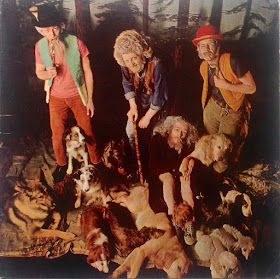Jethro Tull
by Pete Clemons
A pair of albums that have given me immense pleasure over the years, one now over 50 years old and the other fast approaching, are ‘This Was’ and ‘Stand Up’. Both releases were by Jethro Tull and, together, they still get regular outings on my audio devices.
Jethro Tull had been regulars at the prestigious Marquee Club in London throughout 1968 and even featured at their festival, The National Jazz and Blues Festival in Sunbury during August of that year, where they proved to be a huge hit. September 1968 saw the release of the band’s first Island single ‘Song for Jeffrey’.
Prior to ‘This Was’ being recorded, associates of the band, advised Ian Anderson to forget the flute which he had only recently taken up. How wrong he was to prove them. Upon its release, John Peel enthused about it, becoming an early advocate, and gave the album huge airplay. It seemed to catch the music business by complete surprise.
‘This Was’, entered the album chart at number 23 during October 1968 peaking at number 10 mid-November, and was a more than impressive debut record. It was blues-based and featured the line-up of Ian Anderson, flute/vocals, Mick Abrahams, guitar, Glenn Cornick, bass and Clive Bunker on drums.
The final recording of ‘This Was’ was far from perfect but, in their defence, Jethro Tull had not got the weight of a label behind them during its creation. That only came later. A Melody Maker review ‘thoroughly recommended’ the album. It reached number 10 in the charts.
Jethro Tull played Coventry a couple of times during 1968 either side of the release of ‘This Was’.
Early 1969 and Mick Abrahams left Jethro Tull to form Blodwyn Pig. An uneasy alliance had grown as to the direction of the band with Mick wanting to follow the previously embarked bluesy path. Ian Anderson had other ideas however and was becoming more influenced by the more progressive sounds that were springing up at that time.
Securing the services of ex Lanchester Polytechnic student, Martin Barre, the band began their first tour of the U.S. soon afterwards. While in the States, the band quickly picked up a sizeable following.
Jethro Tull’s fourth 45 rpm single, and their first recording with Martin Barre, ‘Living in the Past’, entered the charts at number 41 during May 1969 steadily rising to number 3 over a 6 week or so period.
A second album, the quite brilliant ‘Stand Up’, entered the charts at number 1 during August 1969. At around the same time ‘This Was’ was re-entering the lower reaches.
Ian Anderson, complete with his wild eyes and one-legged stance (a position adopted from his harmonica playing days) along with various other postures and poses, was now in total control of band.
‘Stand Up’ was, I think, still a bluesy album but undoubtedly Jethro Tull were beginning to expand and find their own niche. Some great songs took the album into a host of wonderful directions. Take a listen to ‘We Used to Know’, from ‘Stand Up’ and see if it reminds you of a familiar tune from the mid to late 1970s. Incredibly both bands toured with each other during the early 70s. A further two tunes, ‘Sweet Dream’ and ‘The Witch’s Promise’ kept the band in the singles chart, reaching number 7 and 4 respectively.
The next album up was ‘Benefit’ which entered the chart at number 7 during May 1970, rising to number 3, before dropping down again quickly. ‘Benefit’ was, again, a change in style. It felt more loosely put together in feel with the introduction of piano and organ enabled this. Despite selling over a million copies the critics were not enamoured by it.
‘Benefit’ would be the last album with the Anderson / Barre / Cornick / Bunker line up. Although they still had time, complete with John Evan on keyboards, to appear at the Isle of Wight festival on 30 August 1970 Isle of Wight.
From all accounts Jethro Tull’s performance at the Isle of Wight was impressive from the outset on that final day of the festival. The band were said to have delivered a powerful and charismatic gig. The set included a version of ‘My God’ which featured on the ‘Aqualung’ album, the first album to feature Jeffrey Hammond on bass guitar and vocals.
Incidentally, Ian Anderson, Glenn Cornick and Jeffrey Hammond had been members of the John Evan Band prior to the formation of Jethro Tull. Anderson even wrote a trio of songs, across those first three albums, about Jeffrey Hammonds peculiar behaviours.
Jethro Tull went on to make many wonderful and amazing albums. And some of the lyrics found within those lyrics have a touch of genius. The band still tour today. But those early days of the Tull, along with all the new and exciting sounds being discovered, made them very special indeed.


No comments:
Post a Comment